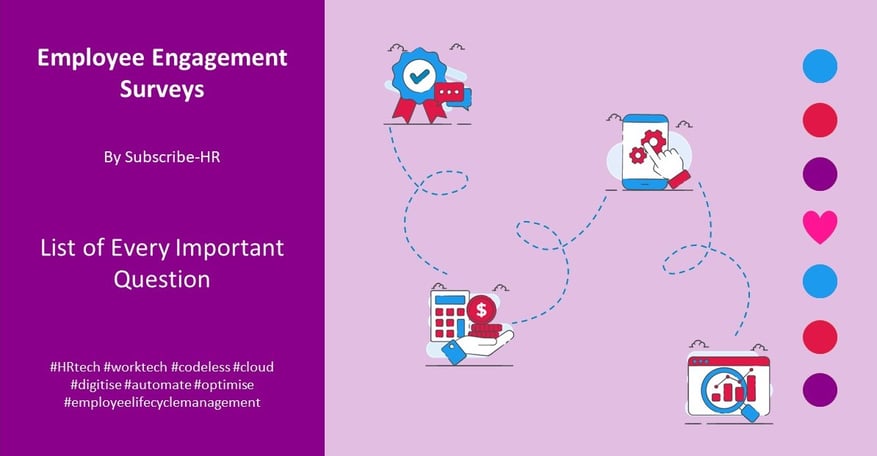Today’s worker is highly disengaged at work. In fact, 85% of the global workforce is not engaged in their workplace. Yet, employees who feel engaged with their work have 87% less chance of leaving their current position.
And with onboarding new hires costing thousands every year, organisations are increasingly trying to improve their employee engagement levels. There are plenty of strategies around to do so, but the first step is gauging your team’s engagement through a well-designed survey. 🌡️
Read on if you want to find out the most important questions to include in employee engagement surveys from HR experts who have seen quite a few surveys, good and bad! ⬇️

What You Need to Know About Employee Engagement Surveys
Engaged employees are more likely to be committed, motivated, and satisfied in their roles, which ultimately leads to better performance and higher retention rates. One effective tool for measuring and improving employee engagement is the employee engagement survey. 👇
How many questions should be in an employee engagement survey?
Typically, employee engagement surveys contain between 10 to 30 questions. The key is to strike a balance between gathering sufficient data to assess engagement and keeping the survey manageable for employees. 👍
We would also recommend narrowing down the different areas of consideration to focus on and sticking to questions surrounding those, just like the questions you’ll find below! ⬇️
What is the KPI for employee engagement surveys?
The main KPIs for employee engagement surveys are:
- Overall engagement score – a composite score that reflects the overall level of employee engagement within the organisation. It's often calculated based on responses to various survey questions.
- Participation rate – the percentage of employees who complete the survey is an important KPI. A higher participation rate suggests greater interest and investment in the survey.
- Net Promoter Score (NPS) – this measures how likely employees are to recommend their organisation as a great place to work. It provides valuable insights into employee satisfaction and loyalty.
- Retention rate – monitoring the retention rate after conducting an engagement survey can help assess its impact. A higher retention rate indicates that employees are more satisfied and committed to their roles.
- Action Plan Implementation – this tracks the execution of action plans based on survey findings. The effectiveness of these plans in improving engagement can be measured through subsequent surveys.
How do you structure an employee engagement survey?
Here's a recommended framework for structuring employee engagement surveys ⬇️
- Brief introduction – start with a brief introduction explaining the purpose of the survey, emphasising that the answers will remain confidential and encouraging honest responses.
- Demographics – include a section for basic demographic information like department, role, and years of service. This data can help identify trends and patterns.
- Employee engagement questions – ask core employee engagement questions surrounding topics like job satisfaction, relationships with colleagues and managers, and opportunities for growth.
- Open-ended questions – ask open-ended questions that allow employees to share their thoughts, suggestions, and concerns in their own words.
- Likert scale – you can also use a Likert scale for most questions, where employees rate their level of agreement on a scale from strongly disagree to strongly agree. This allows for quantitative analysis.
- Outro – conclude the survey with an authentic thank-you message.
- Follow-up – after the survey, communicate the results to employees and outline the action plan that will address the issues identified. It’s really important to regularly follow up on the progress of these plans.
Some best practices to follow for employee engagement surveys
- Make sure your employees feel safe sharing their thoughts. Anonymity and confidentiality are key here, as they encourage open and honest feedback
- Surveys are great, but don't overdo it. Regular surveys are good, but don't pester your employees with them too often
- Take the time to craft well-structured questions. They should be clear and to the point, aligning with your survey's goals
- Don't stick to just one question type. Use multiple-choice, Likert scales, open-ended questions, and more to get a well-rounded view
- Before going full-scale, pilot your survey with a small group. This can help catch any issues with the questions or the survey process
- Tell your employees why the survey matters. Let them know how their feedback will drive positive changes in the workplace
- Get your senior leaders involved. When they show they're on board, it demonstrates the company's commitment to the survey process and its results
- Keep the survey short and easy to access. You want employees to complete it without feeling overwhelmed
- After the survey, share the results and outline what actions you'll take based on the feedback. It's important to show that their input matters
- Focus on collecting data that can lead to real improvements. The goal isn't just to gather data but to use it effectively
- Make sure the survey is accessible to all employees, including those with disabilities or who speak different languages
- Tailor the survey to your company's unique needs. One size doesn't fit all when it comes to engagement surveys.
- Compare your results with industry standards. It provides context and helps you understand where you stand
- Keep your survey methods and questions consistent over time. This allows you to track trends and changes
- Establish a feedback loop to keep the conversation going with employees. Use it to address concerns and measure progress
- Use the survey data as a springboard for continuous improvement. Your goal is to enhance engagement, employee experience, and workplace culture
The 49 Most Important Employee Engagement Survey Questions
General employee engagement questions
How do you feel about work today?
Goal: To gauge the employee's immediate engagement level.
- Using a visual scale with happy to sad faces can make it easy for employees to respond quickly and honestly.
- Keep in mind that this question assesses short-term feelings and may not reflect long-term engagement trends.
Would you recommend [organisation] to your friends as an employer?
Goal: To assess an employee's satisfaction with the organisation and their willingness to endorse it to others, reflecting their engagement and loyalty.
Tips:
- Consider providing a scale (e.g., "Definitely would recommend," "Might recommend," "Would not recommend") to allow for more nuanced responses.
Do you feel excited about coming to work?
Goal: To assess an employee's enthusiasm and motivation toward their job, which is a key indicator of their level of engagement.
Tips:
- Use a Likert scale (e.g., strongly agree to strongly disagree) to capture varying levels of excitement.
- Consider following up with questions that explore the reasons behind their excitement or lack thereof.
Are you proud of working for [organisation]?
Goal: To measure an employee's sense of pride and connection to the organisation, which will likely be indicative of their engagement and commitment.
Tips:
- Allow for open-ended responses to gain deeper insights into why or why not they feel proud.
- Be prepared to address any issues or concerns that may affect an employee's sense of pride in the organisation.
Are you satisfied with your current compensation and benefits?
Goal: To assess the impact of compensation and benefits on an employee's overall job satisfaction and engagement.
Tips:
- Use a structured scale (e.g., very satisfied to very dissatisfied) for easy analysis.
- Consider combining this question with follow-up queries about specific compensation components or benefits that matter most to employees.
Do you enjoy working with your team?
Goal: To evaluate an employee's level of satisfaction and engagement with their immediate team members, as positive team dynamics are crucial for overall engagement.
Tips:
- Use a Likert scale to capture varying degrees of enjoyment.
- Consider supplementing this question with open-ended inquiries to uncover specific areas of concern or improvement.

Organisational alignment questions
Do you find your work for [organisation] meaningful?
Goal: To assess whether employees perceive their work as meaningful and aligned with the organisation's purpose and mission.
Tips:
- Use a Likert scale or agree/disagree options to capture varying levels of agreement.
- Consider adding a follow-up question to understand what specifically makes their work meaningful or where improvements can be made.
Does [organisation]’s vision and values inspire you?
Goal: To evaluate how well the organisation's vision and values resonate with employees.
Tips:
- Provide space for employees to share why or why not they find the vision and values inspiring.
- Consider using a scale to measure the degree of inspiration (e.g., very inspiring to not inspiring at all).
Do others provide you with recognition for your accomplishments at work?
Goal: To assess the recognition and appreciation employees receive from their peers and superiors.
Tips:
- Include follow-up questions to identify specific areas where employees feel recognition could be improved.
- Use a scale or agree/disagree options to quantify the level of recognition.
Do you feel like your supervisor is invested in your success?
Goal: To measure the employee's perception of their supervisor's support and commitment to their professional development and success.
Tips:
- Use a Likert scale or agree/disagree options to capture varying degrees of investment.
- Encourage employees to provide examples or suggestions for improved support.
Does [organisation]’s culture foster a comfortable, supportive work environment?
Goal: To evaluate the organisation's culture and its impact on the comfort and supportiveness of the work environment.
Tips:
- Consider using a scale or agree/disagree options to quantify the level of comfort and support.
- Encourage employees to offer suggestions for enhancing the work environment if they don't find it comfortable or supportive.
Is leadership invested in and contributing to your culture initiatives?
Goal: To examine the role of leadership in shaping and maintaining the organisational culture.
Tips:
- Use a Likert scale to measure the perceived level of leadership involvement.
- Include follow-up questions to gather feedback on what specific culture initiatives are working well or need improvement.
Future orientation questions
Do you see yourself working here in a year?
Goal: To assess an employee's commitment to the organisation and their intention to remain employed.
Tips:
- Use a scale to capture varying degrees of commitment, from "definitely yes" to "definitely no."
- Pay attention to trends in responses, as a high number of employees not seeing themselves at the organisation in a year may indicate potential retention issues.
Does your work challenge you and aid your development?
Goal: To evaluate the extent to which an employee's role provides opportunities for growth, development, and personal challenge.
Tips:
- Use a scale or agree/disagree options to measure the perceived level of challenge and development.
- Encourage employees to provide examples or suggestions for areas where they feel challenged or where development can be improved.
Do you see a path for career advancement at [organisation]?
Goal: To assess whether employees perceive opportunities for career growth within the organisation, which is a key driver of engagement and retention.
Tips:
- Use a scale to measure the perceived clarity of career advancement paths.
- Follow up with questions to gather suggestions for improving or clarifying advancement opportunities if needed.
Do you have the tools needed to maximise your potential here?
Goal: To gauge whether employees have access to the resources and tools necessary for them to perform at their best and reach their potential.
Tips:
- Use a scale or agree/disagree options to measure the perceived access to tools and resources.
- Include open-ended questions to gather specific feedback on what tools or resources employees need.
Have you recently thought about leaving [organisation]?
Goal: To assess whether employees have contemplated leaving the organisation, serving as an early indicator of potential disengagement and retention issues.
Tips:
- Use a scale or agree/disagree options to measure the frequency of such thoughts.
- Monitor trends in responses and act promptly if a significant number of employees have considered leaving.
Has anyone at the company asked about and expressed support for your career goals?
Goal: To evaluate whether the organisation and its employees are actively engaging with and supporting an individual's career aspirations.
Tips:
- Use a scale to gauge the level of support perceived by employees.
- Encourage employees to provide examples of such support or suggestions for improving it.

Open-ended employee engagement questions
What practices do we need to change?
Goal: To invite employees to provide specific feedback on existing practices and processes that may be hindering their engagement or productivity.
Tips:
- Encourage employees to be specific by asking for concrete examples or situations.
Are there any problems with our culture?
Goal: To encourage employees to share their perspectives on the organisation's culture, pinpointing areas where improvements may be needed for better employee engagement.
Tips:
- Provide examples of cultural aspects to help employees focus their feedback.
How can we help improve your engagement at work?
Goal: To empower employees to propose solutions and strategies that can enhance their engagement and job satisfaction.
Tips:
- Encourage employees to think beyond their individual needs and suggest changes that may benefit the entire team or organisation.
Is there anything else you would like to share that you find important to your employee experience here at [organisation]?
Goal: To invite employees to share any additional thoughts or concerns they may have that haven't been covered by previous questions.
Tips:
- Make this question the last one in the survey to ensure employees feel they have a platform for unrestricted feedback.
Leadership and management questions
Do you feel your direct supervisor provides clear guidance and support for your daily tasks?
Goal: To assess the quality of guidance and support provided by an employee's immediate supervisor.
Tips:
- Use a scale or agree/disagree options to capture the perception of guidance and support.
- Encourage employees to provide examples or suggestions for improvement if needed.
Is your manager approachable and receptive to your concerns and ideas?
Goal: To evaluate the approachability and receptiveness of an employee's manager.
Tips:
- Use a scale to measure the perceived approachability and receptiveness.
- Include open-ended questions to gather specific examples of when the manager was approachable or areas where improvement is needed.
Are you satisfied with the level of feedback and performance evaluations you receive from your manager?
Goal: To assess employee satisfaction with the quality and frequency of feedback and performance evaluations.
Tips:
- Use a structured scale (e.g., very satisfied to very dissatisfied) to measure satisfaction.
- Encourage employees to specify what kind of feedback or evaluations they find most valuable or areas where improvements are needed.
Does your manager actively help you with your career development and growth within the company?
Goal: To measure the perceived level of support and assistance from a manager in an employee's career development and growth.
Tips:
- Use a scale or agree/disagree options to quantify the perceived level of assistance.
- Encourage employees to provide examples of how their manager has contributed to their career development or suggest ways in which they can be more supportive.

Communication and feedback questions
How would you rate the overall communication within the organisation, from leadership to front-line employees?
Goal: To assess the effectiveness of communication within the organisation.
Tips:
- Use a scale or agree/disagree options to measure the perceived quality of communication.
- Encourage employees to provide specific examples of effective or ineffective communication.
Do you feel your feedback and suggestions are taken seriously and acted upon?
Goal: To evaluate whether employees perceive their feedback as valued and whether it leads to action, which is crucial for engagement and continuous improvement.
Tips:
- Use a scale to measure the extent to which employees feel their feedback is acted upon.
- Encourage employees to provide examples of when their feedback was addressed and areas where improvement is needed.
Are you well-informed about company updates, changes, and important news?
Goal: T assess how well employees are kept informed about significant developments within the organisation.
Tips:
- Use a scale to measure the perceived level of information dissemination.
- Consider asking what specific channels or methods employees find most effective for receiving updates.
Do you have opportunities to voice your opinions in team meetings or company-wide discussions?
Goal: To evaluate whether employees feel they have a platform to voice their opinions and ideas.
Tips:
- Use a scale to measure the perceived availability of opportunities to provide input.
- Encourage employees to suggest improvements to the current feedback and discussion processes.
Team and collaboration questions
Do you feel a strong sense of teamwork and collaboration among your colleagues?
Goal: This question assesses the level of teamwork and collaboration within the organisation.
Tips:
- Use a scale to measure the perceived level of teamwork.
- Encourage employees to provide examples of effective teamwork or areas where collaboration can be improved.
Is there good cooperation and synergy within your team, department, or workgroup?
Goal: To evaluate the quality of cooperation and synergy within smaller teams.
Tips:
- Use a scale to quantify the perceived quality of cooperation and synergy.
- Encourage employees to suggest improvements for better team dynamics.
Do you believe that your team's goals and tasks align with the overall goals of the organisation?
Goal: To assess whether employees see the alignment between their team's objectives and the broader goals of the organisation.
Tips:
- Use a scale to gauge the perceived alignment.
- Encourage employees to provide examples of how their team's goals contribute to the organisation's success.
Are there any issues or conflicts within your team that need to be addressed?
Goal: To encourage employees to voice concerns about team dynamics, conflicts, or issues that may be affecting their engagement or collaboration.
Tips:
- Create a safe and confidential channel for employees to report issues.
- Develop a follow-up process for addressing and resolving conflicts within teams.

Recognition and appreciation questions
How often do you receive recognition or praise for your work from your peers, manager, or leadership?
Goal: To assess the frequency and effectiveness of recognition and appreciation within the organisation.
Tips:
- Use a scale to quantify the frequency of recognition.
- Encourage employees to provide specific examples of meaningful recognition experiences.
Do you feel your efforts and contributions are genuinely appreciated and acknowledged?
Goal: To assess the sincerity of appreciation and acknowledgment received by employees.
Tips:
- Use a scale to measure the perceived sincerity of appreciation.
- Encourage employees to provide feedback on what forms of appreciation are most meaningful to them.
Is there room for improvement in the way your organisation recognises employees?
Goal: To invite employees to provide suggestions for improving the organisation's recognition and appreciation practices.
Tips:
- Act on valuable suggestions to enhance recognition practices.
- Create an ongoing dialogue with employees about how they prefer to be recognised and acknowledged.
Work-life balance questions
Do you feel your workload is manageable and allows for a healthy work-life balance?
Goal: To assess whether employees perceive their workload as manageable and if it allows for a healthy balance between work and personal life.
Tips:
- Use a Likert scale or agree/disagree options to capture varying degrees of perceived workload manageability.
- Encourage employees to provide specific examples of times when they felt their workload was or wasn't manageable.
Are you satisfied with your current working hours and flexibility options?
Goal: To evaluate employee satisfaction with their working hours and the flexibility offered.
Tips:
- Use a structured scale (e.g., very satisfied to very dissatisfied) to measure satisfaction.
- Consider including a section for additional comments where employees can suggest specific improvements if needed.
Do you feel encouraged to take advantage of paid time off and vacation days?
Goal: To assess whether employees feel encouraged to use their available paid time off and vacation days.
Tips:
- Use a scale to measure the perceived level of encouragement.
- Encourage employees to share examples of when they felt encouraged to take time off or when they didn't.
Is there anything preventing you from achieving a better work-life balance?
Goal: To invite employees to voice any obstacles or concerns that hinder their ability to achieve a healthier work-life balance.
Tips:
- Create a confidential space for employees to express their concerns without fear of reprisal.
- Act on valuable feedback to address specific issues and improve work-life balance support.

Training and development questions
Are there opportunities for ongoing training and skill development in your current role?
Goal: To assess the availability of opportunities for employees to enhance their skills and knowledge in their current role.
Tips:
- Use a Likert scale or agree/disagree options to capture varying degrees of perceived training opportunities.
- Encourage employees to provide examples of training programs they have found valuable or areas where more opportunities are needed.
Do you feel encouraged to take on new challenges and projects that help you grow professionally?
Goal: To evaluate whether employees feel motivated and supported in taking on new challenges and projects.
Tips:
- Use a scale to measure the perceived level of encouragement.
- Encourage employees to share examples of when they were encouraged to take on new challenges or when they were not.
Are you satisfied with the availability of resources and training programs to enhance your skills?
Goal: To assess employee satisfaction with the availability of resources and training programs.
Tips:
- Use a structured scale (e.g., very satisfied to very dissatisfied) to measure satisfaction.
- Collect specific feedback on which resources or programs employees find most valuable or areas where improvements are needed.
Is there a clear career development path and opportunities for advancement within the organisation?
Goal: To evaluate whether employees perceive a defined path for career development and opportunities for advancement within the organisation.
Tips:
- Use a scale to gauge the perceived clarity of career development paths.
- Encourage employees to share their experiences with career advancement or suggest areas where more opportunities are needed.
Diversity and inclusion questions
Do you believe that your organisation values diversity and promotes an inclusive work environment?
Goal: To assess whether employees perceive the organisation's commitment to diversity and inclusion.
Tips:
- Use a scale to measure the perceived commitment to diversity and inclusion.
- Encourage employees to provide specific examples of inclusive practices they've observed or suggest areas where improvements are needed.
Have you experienced or witnessed any form of discrimination or bias within the workplace?
Goal: To encourage employees to share their experiences with discrimination or bias.
Tips:
- Create a confidential reporting mechanism to protect employees who may fear reprisals.
- Develop a clear process for addressing and resolving discrimination or bias complaints.
Are you aware of diversity and inclusion initiatives in place to foster a more inclusive culture?
Goal: To evaluate whether employees are informed about the organisation's diversity and inclusion initiatives, which is crucial for promoting transparency and employee engagement.
Tips:
- Use this question to gather feedback on the effectiveness of current initiatives.
- Encourage employees to suggest additional initiatives or communication methods to promote inclusivity.
What suggestions do you have to improve diversity and inclusion within the organisation?
Goal: This open-ended question invites employees to provide suggestions for enhancing diversity and inclusion efforts, fostering a more inclusive culture, and promoting engagement.
Tips:
- Create a safe and confidential space for employees to express their ideas and concerns.
- Act on valuable suggestions to improve diversity and inclusion practices and demonstrate a commitment to inclusivity.
FAQs – Frequently Asked Questions
Why is employee engagement important?
Employee engagement is crucial because it directly impacts an organisation's productivity, retention rates, and overall success. Engaged employees are more committed, motivated, and satisfied in their roles, leading to better performance and lower turnover.
How many questions should an employee engagement survey typically contain?
Employee engagement surveys usually consist of 10 to 30 questions. The key is to strike a balance between gathering enough data to assess engagement and keeping the survey manageable for employees.
What are the key KPIs for employee engagement surveys?
The main KPIs for employee engagement surveys include overall engagement score, participation rate, Net Promoter Score (NPS), retention rate, and Action Plan Implementation. These metrics provide insights into the level of engagement and its impact on the organisation.
How should I structure an employee engagement survey?
A well-structured employee engagement survey should include a brief introduction, demographics section, employee engagement questions, open-ended questions, Likert scale questions, an outro, and a follow-up plan. This structure ensures comprehensive feedback and a clear path for action.
What are some best practices for conducting employee engagement surveys?
Best practices include ensuring anonymity and confidentiality, conducting surveys at a reasonable frequency, using well-designed and diverse question types, pilot testing surveys, communicating the survey's purpose, engaging leadership, keeping the survey short and accessible, sharing results, and creating a feedback loop for ongoing dialogue with employees.
What are some general employee engagement questions and their goals?
General employee engagement questions aim to assess immediate engagement and include queries about how employees feel about their work, their willingness to recommend the organisation, their excitement about work, pride in working for the organisation, compensation and benefits satisfaction, and enjoyment of working with their team.
What are some organisational alignment questions and their goals?
Organisational alignment questions assess the alignment between employees and the organisation's mission, values, recognition for accomplishments, supervisor support, and the organisation's culture and leadership's role in fostering a comfortable work environment.
What are some future orientation questions and their goals?
Future orientation questions evaluate employees' commitment to the organisation, job challenge and development opportunities, perceptions of career advancement, access to tools for maximum potential, thoughts of leaving the organisation, and support for their career goals within the company.
What are some open-ended employee engagement questions and their goals?
Open-ended questions invite employees to provide specific feedback, share concerns about the organisation's culture, suggest ways to improve engagement, and express any other important thoughts or concerns they have about their employee experience.
What are some leadership and management questions and their goals?
Leadership and management questions help assess the quality of supervision, manager approachability and receptiveness, satisfaction with feedback and performance evaluations, and the level of manager support for employee career development and growth within the company.
What are some communication and feedback questions and their goals?
Communication and feedback questions evaluate the effectiveness of organisational communication, whether employee feedback is taken seriously and acted upon, how well employees are informed about company updates, changes, and important news, and whether employees have opportunities to voice their opinions in discussions.
What are some team and collaboration questions and their goals?
Team and collaboration questions assess the sense of teamwork and collaboration among colleagues, the quality of cooperation and synergy within teams, the alignment of team goals with organisational goals, and the presence of issues or conflicts within teams.
What are some recognition and appreciation questions and their goals?
Recognition and appreciation questions measure the frequency and sincerity of recognition and praise for employees' work, and whether there's room for improvement in the way the organisation recognises employees.
What are some work-life balance questions and their goals?
Work-life balance questions assess the manageability of workloads, satisfaction with working hours and flexibility, whether employees feel encouraged to take paid time off and vacation days, and if anything is preventing them from achieving a better work-life balance.
What are some training and development questions and their goals?
Training and development questions evaluate the availability of training opportunities, encouragement to take on new challenges and projects, satisfaction with resources and training programs, and whether there is a clear career development path and opportunities for advancement.
What are some diversity and inclusion questions and their goals?
Diversity and inclusion questions assess whether employees believe the organisation values diversity and promotes inclusivity, whether they've experienced or witnessed discrimination or bias, and whether they're aware of diversity and inclusion initiatives and have suggestions for improvement.

